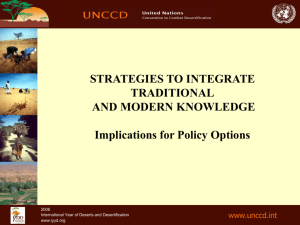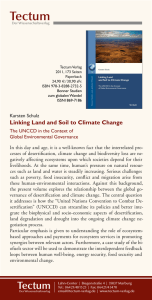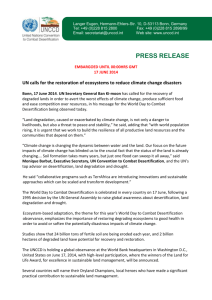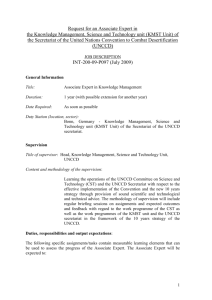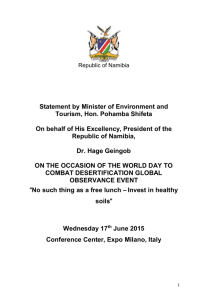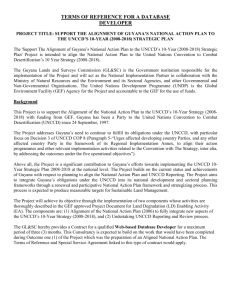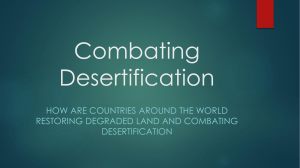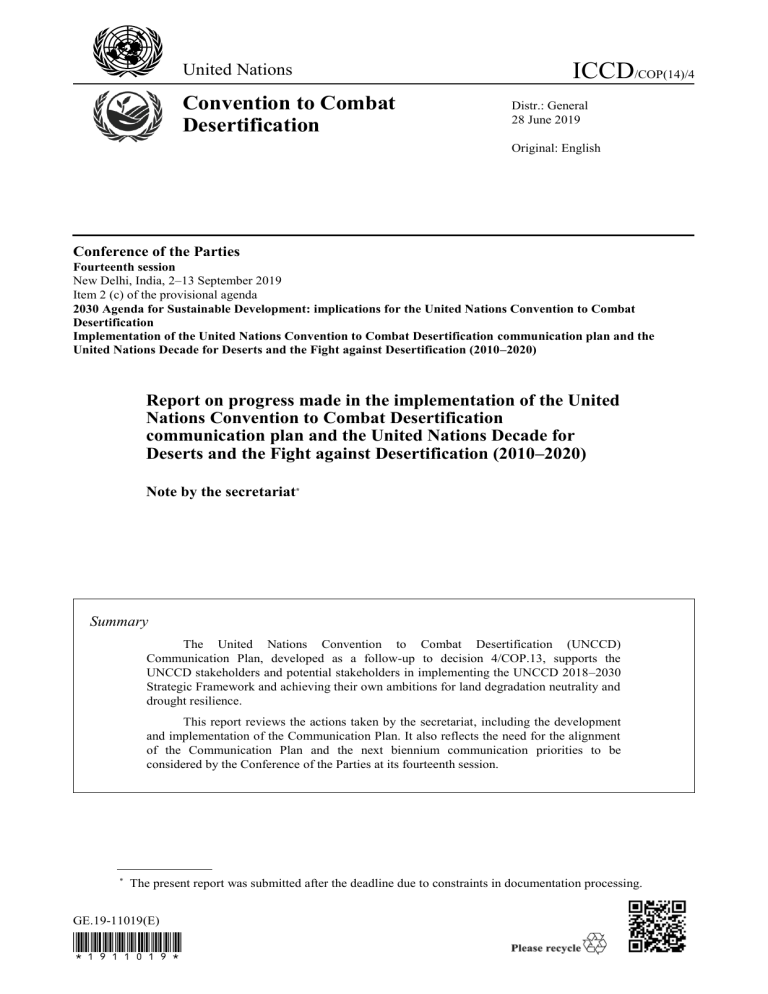
United Nations Convention to Combat Desertification ICCD/COP(14)/4 Distr.: General 28 June 2019 Original: English Conference of the Parties Fourteenth session New Delhi, India, 2–13 September 2019 Item 2 (c) of the provisional agenda 2030 Agenda for Sustainable Development: implications for the United Nations Convention to Combat Desertification Implementation of the United Nations Convention to Combat Desertification communication plan and the United Nations Decade for Deserts and the Fight against Desertification (2010–2020) Report on progress made in the implementation of the United Nations Convention to Combat Desertification communication plan and the United Nations Decade for Deserts and the Fight against Desertification (2010–2020) Note by the secretariat* Summary The United Nations Convention to Combat Desertification (UNCCD) Communication Plan, developed as a follow-up to decision 4/COP.13, supports the UNCCD stakeholders and potential stakeholders in implementing the UNCCD 2018–2030 Strategic Framework and achieving their own ambitions for land degradation neutrality and drought resilience. This report reviews the actions taken by the secretariat, including the development and implementation of the Communication Plan. It also reflects the need for the alignment of the Communication Plan and the next biennium communication priorities to be considered by the Conference of the Parties at its fourteenth session. * The present report was submitted after the deadline due to constraints in documentation processing. GE.19-11019(E) ICCD/COP(14)/4 Contents Paragraphs Page I. Background ............................................................................................................. 1–3 3 II. Implementation progress ......................................................................................... 4–39 3 A. World Day to Combat Desertification and Drought (2017–2018) .................. 4–12 3 B. United Nations Decade for Deserts and the Fight against Desertification (2010–2020).................................................................................................... 13–15 4 C. Media outreach ............................................................................................... 16–26 5 D. Digital communication ................................................................................... 27–31 7 E. Information dissemination .............................................................................. 32–35 9 E. Land for Life Programme ............................................................................... 36–39 9 III. Focus of the next biennium (2020–2021) ................................................................ 40–56 10 IV. Conclusions and recommendations ......................................................................... 57–60 12 Annex Financial requirements for the implementation of the activities to be funded from extra-budgetary resources ....................................................................................... 2 14 ICCD/COP(14)/4 I. Background 1. The United Nations Convention to Combat Desertification (UNCCD) 2018−2030 Strategic Framework recognizes awareness-raising as a key element in addressing desertification/land degradation and drought (DLDD). At the thirteenth session of the UNCCD Conference of the Parties (COP 13), Parties requested the secretariat to develop a short communications plan with objectives, key messages and channels to consistently advance the Convention’s positions and identity, based on the UNCCD 2018–2030 Strategic Framework (decision 4/COP.13 para.3(a)). 2. As a result, the new UNCCD Communication Plan (2018–2030) was developed based on internal and external consultations and with the data collected from over 100 survey participants. The Plan provides basic guidelines for the UNCCD staff and stakeholders on what to communicate and how to deliver coherent UNCCD messages to targeted audiences. The document is available on the UNCCD website.1 3. Under the new Executive Direction, the implementation of the Plan was reviewed in March 2019 to ensure alignment with the UNCCD strategic direction for the next biennium. The outcomes are summarized in section IV: Focus of the next biennium (2020–2021). II. Implementation progress A. World Day to Combat Desertification and Drought (2017–2018) 4. Declared by the United Nations General Assembly in 1995, the World Day to Combat Desertification and Drought (WDCD) is observed every year on 17 June to promote public awareness of international efforts to combat desertification. This report covers the WDCD observance activities since the last activity reported in document ICCD/COP(13)/4, namely the years 2017, 2018 and 2019. 5. In 2017, global observance of the WDCD took place on 15 June at the Centre des Conférences de Ouaga 2000, in Ouagadougou, Burkina Faso, hosted by the Ministry of the Environment, Green Economy and Climate Change of Burkina Faso. Over 400 international and local participants attended the ceremony, including eminent personalities such as the Heads of State from Burkina Faso, Mali and Niger. During the global observance, these three Heads of State made a joint statement, which endorsed a call for action on land-based jobs to tackle Africa’s three big interlinked challenges – Sustainability, Stability, and Security (3S) – through the 3S initiative. The call for action was the outcome of a high-level symposium of ministers and other government officials that formed part of the 2017 global observance event. The report of the global observance event is available here.2 6. Seventy-eight governmental and intergovernmental organizations and civil society organizations (CSOs) reported their observance activities to the secretariat. An interactive event map was created, allowing the website visitors to view the events and add their own celebrations to the map.3 7. The 2017 WDCD online campaign, conducted in collaboration with Korea Future Forest, Korean Eco Science TV, World Federation of United Nations Associations Korea, China Green Foundation and Ant Financial Services, reached 552,079 people, mostly youth. The campaign, promoted through crowdspeaking platform Thunderclap, reached out to more than one million people. Public opinion on the restoration story by the China Green 1 2 3 <https://www.unccd.int/sites/default/files/relevant-links/201904/7.9%20UNCCD%20Communication%20Plan.pdf>. <https://www.unccd.int/actions/actions-around-world/report-global-observance-world-day-combatdesertification-burkina-faso>. <https://www.unccd.int/actions/17-june-world-day-combat-desertification/2017-wdcd-events-aroundworld>. 3 ICCD/COP(14)/4 Foundation included more than 100,000 readers and received 1,631 likes on the WeChat platform. 8. In 2018, the WDCD urged people to move away from unsustainable land use and make a difference by investing in the future of land under the slogan, “Land has true value – invest in it.” The global observance event was held in Ciudad Mitad del Mundo – ‘the city in the middle of the world’ – in Ecuador, hosted by the Ministry of Environment and the Ministry of External Relations and Human Mobility of Ecuador. Approximately 100 people participated in the event. In addition to Ecuador’s Minister of External Relations and Human Mobility and Minister of the Environment, the UNCCD National Focal Point (NFP) Ministers from Grenada, Guyana and Jamaica, the Vice Minister of Poland and the National Secretary of Water Resources of Ecuador participated in the event. At the opening, a video message from H.E. Ms Tarja Halonen, the UNCCD Drylands Ambassador and former President of Finland, was presented. Active exchanges took place at the ministerial round table on “Policies and practices to invest in sustainable land management (SLM)”. The Government of Ecuador showcased its efforts in achieving land degradation neutrality (LDN) through bio-economy, a pillar concept of the National Development Plan (2017– 2021). The report of the 2018 global observance event is available here.4 9. Eighty-eight governmental and intergovernmental organizations and CSOs reported their WDCD events, which have featured on an interactive map on the UNCCD website.5 The WDCD online campaign expanded in 2018, with 584,581 people engaged overall. 10. On the occasion of the 25th anniversary of the Convention, the WDCD in 2019 celebrated the 25 years of progress made by countries in sustainable land management under the slogan, "Let's grow the future together." The WDCD global observance and the 25th anniversary of the Convention took place in Ankara, hosted by the Government of Turkey in conjunction with the UNCCD media workshop and the 10th International Soil Congress. Close to 3,000 people attended. President of Turkey H.E. Recep Tayyip Erdogan sent a message to the event, speaking about the Turkish efforts in combating desertification and the tangible outcome they have achieved. Messages were also received from the United Nations Secretary-General, the Executive Secretaries of the Convention on Biological Diversity and the United Nations Framework Convention on Climate Change, the United Nations Development Programme Administrator and the United Nations Environment Programme Executive Director.6 11. During the event, the winners of the WDCD 2019 international photo contest, organized by the Government of Turkey, were recognized. The 2019 Land for Life Award winners were announced by H.E. Mr. Mahdi Mohammed Gulaid, Deputy Prime Minister of Somalia. At the ministerial round table, high-level government officials including eight Ministers and Vice Ministers from 12 countries shared solutions towards achieving land degradation neutrality at the country level. A tribute for late Hama Arba Diallo, the first Executive Secretary of the UNCCD, took place a part of the 25th commemorative event. 12. By the time this report is prepared, 64 governmental and intergovernmental organizations and CSOs reported their WDCD events to the secretariat.7 B. United Nations Decade for Deserts and the Fight against Desertification (2010–2020) 13. The United Nations Decade for Deserts and the Fight against Desertification (UNDDD) began in 2010 and ends in 2020. Its focus since 2014 was raising awareness on 4 5 6 7 4 <https://www.unccd.int/actions17-june-world-day-combat-desertification/2018wdcd-globalobservance-ecuador>. <https://www.unccd.int/actions/17-june-world-day-combat-desertification/2018wdcd-events-aroundworld>. <https://www.unccd.int/actions17-june-world-day-combat-desertification/2019wdcd-globalobservance-ankara-turkey>. <https://www.unccd.int/actions17-june-world-day-combat-desertification/2019wdcd-events-aroundworld>. ICCD/COP(14)/4 gender in the implementation of the Convention. This continued in 2018, with the genderrelated work aimed at providing technical support to Parties, upon request, on how to mainstream gender in their work. 14. The achievements of the UNDDD since 2010 have brought attention to various issues, including desertification in the drylands, the impacts of drought and the importance of dry forests and gender mainstreaming in the implementation of the Convention. They have also showcased actions on the ground through feature stories, pictures and videos. The campaign reached out to scientists, policy-makers, environmental activists and CSOs. However, little attention was given to young people, particularly children and youth. To increase the outreach among youth, the UNCCD secretariat worked with the United Kingdom-based global education charity, Trust for Sustainable Living to ensure that LDN became the focus of its International Schools Essay Competition, whose theme for 2019 is SDG 15 – Life on Land. 15. In March 2019, the United Nations General Assembly declared 2021–2030 as the United Nations Decade for Ecosystem Restoration, stressing “the need to step up efforts to tackle desertification, land degradation, erosion and drought” and “the need for cooperation, coordination and synergies in the work related to ecosystem restoration among relevant United Nations entities, according to their mandate”. Resolution A/RES/73/284 invites the Food and Agriculture Organization of the United Nations and the United Nations Environment Programme (UNEP) to lead the implementation of the decade through a collaborative approach that includes, inter alia, the secretariats of the Rio Conventions. C. Media outreach 16. Decision 4/COP.13 requested the secretariat to enhance the effectiveness of media outreach through partnerships, the development of contact databases, media training, increased publication of people-focused stories and improved delivery and dissemination of products (para. 3(e)). 17. During the biennium, there was an increase in the amount of media coverage related to the issues of the Convention with distinct patterns in evidence. Developing countries reported mostly on country initiatives to combat desertification while developed country reports focused on drought and land degradation. In this regard, the publication of the World Atlas on Desertification, the European Union Auditors’ Report on the status of land degradation in Europe and the growing interest in the impacts of land-based carbon emissions all played an important role. In general, the concerns that prompted most of the reports were conflict, climate change, environmental migration, sand and dust storms, food and water scarcity. 18. UNCCD products: The secretariat and the Global Mechanism (GM) of the UNCCD continued to engage with the media by disseminating products such as opinions and press releases, providing policy positions and new information and by driving traffic to substantive content. In addition, the secretariat organized press conferences for engagements with high-ranking officials. Media reports were monitored on a daily basis to identify trends in global reporting about the Convention, its work and potential reputational risks for mitigation. 19. Media outreach took various forms, including direct emailing through the UNCCD’s growing database and partners in the United Nations system, pitching to individual journalists, partnerships with media networks and associations and through social media. New products, such as short trailers and videos, as well as approaches – e.g. integrating print and multimedia products – to increase outreach were introduced to amplify both media and public outreach. The new products included feature stories, the science policy blog, human interest stories, short videos and trailers. Use of archival material from film projects developed earlier by the UNCCD and GM resulted in significant cost efficiency. The campaign on gender around International Women’s Day on 8 March, for instance, drew on contributions from CSOs. 5 ICCD/COP(14)/4 20. On average, an opinion was published on a global media platform every two months. Balanced language diversity and geographic outreach were achieved mostly through earned media, e.g. Xinhua News Agency, China Central Television, Al Jazeera and Al Arabia. A need to strengthen the engagement with the Russian-speaking media to promote the work of the Convention on the national and regional levels has been identified. 21. The film trailers on the LDN Fund were featured in highly visible events such as the One Planet Summits. The most recent LDN film trailer has attracted the highest number of viewers of all the short videos featured for these Summits, which is also one of the most viewed UNCCD videos. The results show the added value in combining mainstream and social media to increase outreach. 22. The need to engage new formats to popularize content is confirmed by the success of the science-policy blog in the UNCCD Knowledge Hub that has attracted a wide range of contributors, from leaders at the highest level of government to scientists and practitioners in the field. Analysis shows that the demand is highest for blogs that offer practical handson knowledge. 23. Partnerships: The secretariat extended its partnership with the Inter Press Service (IPS), the world’s largest network of developing country journalists, to support outreach and information dissemination on UNCCD and GM initiatives. At the time this report was prepared, the IPS had published 22 news and feature stories – more than the number required under the Memorandum of Understanding – between April 2018 and March 2019. The stories highlighted country initiatives and activities in different parts of the world, and were mostly published around key UNCCD events, including the 2018 and 2019 World Day to Combat Desertification, the seventeenth session of the Committee for the Review of Implementation of the Convention (CRIC 17) and COP 14. With the network’s assistance, the UNCCD has published and posted ten feature stories on its activities. 24. The partnership enabled the secretariat to gather and publish, at an affordable cost, articles about Convention-related activities authored by journalists with regional expertise and for a mostly global business audience. For instance, an article about land restoration in Ghana was re-published by The Boston Herald. The majority of the stories have been translated into French and Spanish. Each article has been re-published in at least 60 national and/or subnational media outlets. 25. Database development: Direct outreach to journalists also grew due to a large subscription by journalists from India in the lead-up to COP 14. The UNCCD database grew by 46 per cent. Analyses show that between 15 and 20 per cent of the subscribers view the media messages. Compared to the last biennium, the trend has risen by around one to four percentage points. The industry average is around 21.5 per cent of viewers for every press product sent out. The analyses show that articles on accreditation for official meetings received the greatest media attention. To increase interest in the disseminated pieces, the secretariat issues press and media releases strategically, using them only to issue information for direct media consumption (such as announcements of press events) or disseminate key information, such as new scientific findings. 26. Capacity-building: The secretariat conducted capacity-building events for journalists, mostly aligned with key UNCCD major events. These included a one-day media workshop held in Georgetown in preparation for CRIC 17. Another three workshops were under development as this report was being written. A one-day international media workshop took place in Ankara, Turkey from 16 to 19 June 2019, with a one-day thematic training session, a field trip and three-day science workshops at the International Soil Congress. A two-day capacity workshop for 30 journalists in India and the Southern Asia Region (ARC) is planned to take place in July and a one-day workshop and two weeks of thematic briefings are planned during COP 14. Journalists sponsored for the events undergo a rigorous competitive selection process designed to attract media professionals with a proven interest in covering topics relevant to the work of UNCCD, who are either skilled writers or potentially good trainers. In this regard, more steady and long-term financial support for media training will help: (a) build the capacity of younger journalists interested in the subject; and (b) ensure collaboration with media networks to increase their engagement. For example, the UNCCD and Convention on Biological Diversity (CBD) 6 ICCD/COP(14)/4 processes have developed a large pool of journalists through partnerships with the Earth Journalism Network. D. Digital communications 27. Decision 4/COP.13 requests the secretariat to strengthen the Convention’s public image with the production of branded material and ensure that the Convention’s website, social media channels, newsletter and library information services contain dynamic and interactive content (para. 3(d)). During the current reporting period, the secretariat increased the amount of multimedia content produced, including social media videos created for the WDCD. 28. The UNCCD website is the hub of the entire UNCCD online presence. It is the institutional memory depository over which the Convention has full control and ownership. By contrast, social media platforms are used as networking platforms and to drive traffic to the UNCCD website. However, none of the tools are used in isolation. Cross-platform content and linkages between the website and social media, and among various platforms, are strategically used to increase public interest in UNCCD issues and bring them to the UNCCD website. 29. Figure 1 shows the changes in the number of unique visitors to the UNCCD website since October 2017, with an apparent increase in visitors. Access to the UNCCD website by continent as registered by Google Analytics shows that the majority of users are from Europe, followed by Asia, the Americas, Africa and the Pacific (Figure 2). Due to the limits of Google’s global accessibility, however, the statistics do not account for all visitors to the UNCCD website. 30. The table found on page 8 shows the increase in UNCCD social media outreach from May 2017 to April 2019. Social media platforms – Facebook, Twitter, Instagram, Weibo, LinkedIn and Youtube – were used to promote UNCCD thematic issues such as drought, SLM and the financing of LDN to more diverse and extensive audiences. For example, during the High-level Political Forum 2018 which reviewed SDG15, a series of social messages were created to give visibility to SDG15.3. Outreach of more than 100,000 was recorded within a week. 31. As more and more young people voice environmental concerns, a number of social media actions have been aimed at younger audiences to connect their interest in nature conservation to the benefits of SLM. For example, the social media campaign, ‘#LoveLand4Climate,’ conducted on the margins of the twenty-third session of the United Nations Framework Convention on Climate Change Conference of the Parties (COP 23), mobilized nearly 500 people (mostly youth) to use the campaign slogan, with total outreach of 405,893. A series of online and off-line awareness-raising forums targeting young audiences also took place in cooperation with the UNCCD Capacity Building Marketplace, as reported in documentICCD/CRIC(18)/8. 7 ICCD/COP(14)/4 Figure 1 Unique visitors to the United Nations Convention to Combat Desertification web page between October 2017 and April 2019 Figure 2 Access to the United Nations Convention to Combat Desertification website by continent, as registered by Google Analytics Table 1 Social media outreach 8 Social media tool Outreach May 2017 Outreach April 2019 Increase in % Facebook 17 604 likes 23 000 likes 30.7 Twitter 13 041 followers 18 300 followers 40.3 Weibo 34 933 followers 40 123 followers 14.9 ICCD/COP(14)/4 E. Information dissemination 32. During this reporting period, seven brochures were published for awareness-raising purposes. In addition, “A Better World”, the book sub-titled “Life on Land”, which focuses on SDG15, target 15.3, was published in partnership with the UK publisher Tudor Rose. These publications were distributed at major UNCCD and external events, including CRIC 17 and the Global Landscapes Forum as well as national and regional events through the Regional Coordination Units of the secretariat. 33. UNCCD News Alert – an update of the materials published on the UNCCD web page – is sent out bi-weekly to approximately 30,000 subscribers. This constitutes a 30 per cent increase from the previous number of 23,000 subscribers reported in document ICCD/COP(13)/4. Email was also used to send out target-specific communication messages that require action and response from the recipients – e.g. a request for input to the WDCD events around the world web page. 34. The Knowledge Hub and library catalogue are among the most visited resources on the UNCCD website, indicating the high interest of the web page visitors in knowledge resources related to DLDD. A more detailed report on the Knowledge Hub is available in ICCD/COP(14)/CST/5. 35. Other promotional materials produced during the reporting period included posters, postcards, pens and eco-bags, which were distributed both at UNCCD-organized and relevant outside events. Furthermore, a documentary on drought was produced to support the UNCCD Drought Initiative and increase awareness among the public and policy-makers on the importance of drought preparedness. F. Land for Life Programme 36. The Land for Life programme, supported by the Elion Foundation based in China, engages in a variety of awareness-raising and knowledge support activities to educate the public and policy on the importance of achieving LDN and the benefits of implementing SLM practices.8 37. The Land for Life Award was launched at COP 10 in 2011 in the Republic of Korea as part of the Changwon Initiative. The award aims to recognize outstanding and inspiring cases of SLM practices and exemplary leadership in the restoration of degraded lands. Thirteen winners have been selected between 2012 and 2017. 38. The Award is now given out biennially. The 2017 Land for Life Award was given to nominees whose work has provided tangible evidence of improving human security and transforming the lives of communities affected by land degradation. The award winners were announced at the global observance of WDCD in Ouagadougou, Burkina Faso. The 2017 Land for Life Award winners were: the Watershed Organisation Trust in India; UNEP and Practical Action Sudan from Sudan; and Ms Yingzhen Pan, Director General of the National Bureau to Combat Desertification, State Forestry Administration. Ms Florencia Escudero Fonseca from Spain also received a special mention. The award ceremony took place during the sixth Kubuqi International Desert Forum held from 28 to 30 July 2017 in Inner Mongolia, China. 39. The 2019 award under the theme ‘Decades of Impact,’ will shine the spotlight on individuals and organizations having made an outstanding contribution to LDN on a large scale, with sustainable changes and dedicated actions over 25 years or longer and remarkable positive impacts on land, people, communities and society. The award winners were announced at the global observance of the WDCD in Ankara on 17 June 2019. 8 More information about Land for Life programme is available at: <https://www.unccd.int/actions/land-life>. 9 ICCD/COP(14)/4 III. Focus of the next biennium (2020–2021) 40. The implementation of the UNCCD Communication Plan has resulted in a notable improvement in the communication activities of the secretariat, as evidenced by the increases in media stories and online visitors reported in section II: Implementation progress. The UNCCD staff retreat on 25 March 2019 and a communication strategy meeting on 7 and 8 May have reviewed the Communication Plan to further strengthen its effectiveness as a tool for supporting the implementation of the UNCCD 2018–2030 Strategic Framework. These meetings also examined recent trends in communication approaches, especially on social media, to increase the outreach to various target groups. The following focus areas are proposed as primary goals for the implementation of the UNCCD Communication Plan for the next biennium. 41. Strategic orientation: All activities under the UNCCD Communication Plan are designed to assist the UNCCD stakeholders and potential stakeholders in implementing the UNCCD 2018–2030 Strategic Framework and achieving their ambitions for LDN and drought resilience. This will remain the primary goal in the implementation of the Plan during the next biennium. 42. The communication activities for the next biennium aim to strengthen the UNCCD brand through an integrated approach involving all UNCCD stakeholders across various communication platforms, complemented by cohesive and convincing messages backed by sound scientific evidence that highlights the benefits of productive land for achieving the SDGs. In this regard, scientific and technical data, information and policy recommendations from the Global Land Outlook (GLO) and other major scientific assessments will be fully employed. 43. To enhance the effectiveness of communication outreach, the emphasis will be on increasing content and delivering messages on the pivotal role of land not only in ecosystem restoration but in achieving poverty eradication and providing income-generating opportunities while addressing the food crisis, hunger, health, water scarcity, energy challenges, climate change, loss of biodiversity, deforestation, environmental migration, and peace and security. Gender equality and women’s empowerment will be an integral part of these messages. 44. It is equally important that these messages are delivered to the targeted audiences at the right time through suitable means. The messages are created and strategically delivered across the UNCCD audiences and various communication platforms. Cooperation with other SDG platforms will be strengthened, including Rio Conventions and relevant United Nations organizations. 45. In general, successful advocacy communications require clear objectives, knowledge of the intended audience, language tailored to the audience and messages that are succinct, specific and to the point. Ultimately, the implementation of the Communication Plan should educate the audience on the benefits of productive land for achieving the SDGs overall and propel the audience into action for SLM. 46. Narrative: The UNCCD has its clear mandate, focus and raison d'être. However, branding and communicating involves some complexity. For example, words such as ‘desertification’ and ‘LDN’ are difficult for most people to understand and relate to. This has long been a stumbling block for public engagement. For the purposes of better communication, LDN must be explained in a way that the general audience can understand and find relevant through clear narratives along with action-oriented and positive messages. Linking UNCCD issues to other sustainable development challenges is a way to promote the understanding of the Convention’s core issues among the public, especially youth. 47. In the last biennium, some significant facts and data on DLDD became available through major review and assessment reports such as the GLO, Science-Policy Interface Report and Policy Brief, World Atlas of Desertification and Intergovernmental SciencePolicy Platform on Biodiversity and Ecosystem Services land degradation assessment. Furthermore, the reports submitted to the CRIC serve as valuable resources on the implementation progress of the Convention. The data and findings in these reports and 10 ICCD/COP(14)/4 publications can be fully utilized for communication and advocacy purposes if presented through the lens of real-life challenges that affect real people. 48. Further, increasing public attention on the The Great Green Wall of the Sahara and the Sahel Initiative (GGWSSI), that is proving remarkably successful, could be a leap forward in the recognition of SLM benefits among policy-makers and the public. Linking the GGWSSI success stories to the communication activities could help promote the understanding of UNCCD issues among the public and inform them on the relevance of achieving LDN. The report on the GGWSSI is available in document ICCD/CRIC(18)/7. 49. Role of communication for advocacy: The 2030 Agenda for Sustainable Development stresses the importance of the synergies between the global goals in realizing the 2030 Agenda. While the successful implementation of SDG target 15.3 can contribute to achieving those goals explicitly and other goals substantially, recognition as such must be given by the stakeholders in favour of achieving these SDGs. This calls for an advocacy strategy that would mobilize the support of relevant processes and actors to adequately support target 15.3 across policy platforms engaged in SDG implementation. The secretariat will strengthen its partnerships and networks – including with relevant United Nations organizations such as the Rio Conventions and United Nations country teams – to amplify co-benefits and use resources more effectively. Strategic opportunities for integration are presented in Figure 3. Figure 3 Strategic opportunities for integration UNEA: United Nations Environment Assembly UNCCD: United Nations Convention to Combat Desertification UNFCCC: United Nations Framework Convention on Climate Change CBD: Convention on Biological Diversity 50. Further, the UNCCD NFPs are the strongest partners to mobilize support and promote the role of SLM in achieving SDGs at national and regional levels. The Convention must increase communication support to the Parties by developing a range of materials that can be adapted to the regional and national context. 51. The Rio Conventions Pavilion (RCP) is a collaborative platform that promotes synergies among the Rio Conventions at the implementation level and showcases activities that link biodiversity conservation and sustainable use, SLM and efforts to combat desertification, and climate change mitigation and adaptation. The RCP will be organized for the 14th time at the UNCCD COP 14. While the RCP has served to increase cooperation among the Conventions, it should also serve to demonstrate that taking advantage of the synergies among Conventions can accelerate the achievement of SDGs and ensure the 11 ICCD/COP(14)/4 strategic and efficient use of the available resources. The role of RCP in policy and advocacy efforts beyond the COP to the Rio Conventions requires further exploration. 52. Strategic partnerships: The Convention’s communication activities must leverage advocacy opportunities offered by existing and potential networks of individuals, groups and organizations who support the UNCCD mission and are able to promote the Convention and increase its visibility. CSOs, entrepreneurs and influencers will be approached for collaboration. UNCCD Drylands Ambassadors representing various gender, geographical and language perspectives must be strategically engaged to increase public interest in the UNCCD issues and promote the role of land in achieving the SDGs. The Land for Life Programme will be developed beyond a communication product to become a policy advocacy tool in support of SDG target 15.3. 53. Strengthening communication capacity: The capacity of secretariat staff will be strengthened to better support the communication activities that influence relevant processes and actors in integrating target 15.3 into the policy platforms for other SDGs. To fulfil this mission and deliver consistent and coordinated messages, the staff must be well versed in the UNCCD issues, which will require an improvement in internal information sharing and the development of guidelines as well as staff training sessions in communications and the use of social media. 54. Heightened visibility in the global media: The secretariat will continue innovative and enhanced media engagement through partnerships, capacity development, the publication of opinions and feature stories and enhanced messaging, including through the use of art and visual products. It will also increase outreach to non-English speaking countries by strengthening regional media relations and developing visual communications to overcome language barriers. 55. Digital transformation: Social media supports real-time and interactive communication with stakeholders. For a small convention secretariat, the use of social media can be a cost-effective and efficient tool with which to expand outreach. The engagement of UNCCD NFPs together with national and regional organizations will play a key role in the creation of content and its distribution in all UN languages. Strategic use of social media and social media campaigns will be mapped with due consideration of relevant guidelines, measures of accountability and a code of ethics. 9 56. To maximize the traditional and social media outreach potential, multimedia content will be further developed, focusing on visually attractive materials that excite the audience and prompt action against land degradation and desertification. A multimedia production strategy will be developed to support integrated web and social media promotion for publications and news stories. IV. Conclusions and recommendations 57. For the next biennium, strategic action at major international forums will be focused on raising the profile of land management as an indicative solution to the 2030 Agenda for Sustainable Development. The communication activities will focus on: (a) promoting consistent and coordinated messages at international forums and through national, regional and global media channels; (b) increasing the production of communication content to improve social media engagement; (c) raising the visibility of DLDD in the global media; and (d) mobilizing prominent friends of the UNCCD to advocate for the Convention and raise its visibility. 58. The outreach efforts will be strengthened through a positive narrative to increase understanding of the benefits of SLM and encourage action towards achieving LDN and drought resilience. To fulfil this commitment, UNCCD stakeholders and potential partners must be given access to innovative, customizable communication resources. 9 12 The secretariat follows the policies and guidelines of the website and social media published by the United Nations. For example, see: <https://www.un.org/en/ethics/pdf/UN_Personal_Use_Social%20Media_Guidelines_Feb_2019.pdf>, <https://www.un.org/en/ethics/pdf/putting_ethics_to_work_en.pdf>. ICCD/COP(14)/4 59. In view of the above, Parties may wish to consider the following: (a) Leveraging international awareness-raising opportunities such as the World Day to Combat Desertification and Drought, the United Nations Decade for Desertification and the Fight against Desertification (2010–2020) and the United Nations Decade of Ecosystem Restoration, to mobilize the public, especially young people, at national and regional levels, around actions to achieve LDN and drought resilience; (b) Building on experience, continuing the innovation of products and processes to enhance media engagement and developing partnerships with media organizations, especially public radio and television, to expand the media reach to non-English speaking audiences; (c) Identifying influential media outlets in each region and developing partnerships with them to achieve broader geographic reach, information dissemination and training; (d) Developing new multimedia content based on scientific and technical data, such as factsheets, infographics, photo stories and short videos, success stories and policy recommendations from the GLO and other major scientific assessments, as well as the performance review and assessment of implementation reports submitted to the CRIC and the successful stories from the GGWSSI; (e) Establishing strategic partnerships with external entities with expertise in the production of multimedia content to optimize resources and increase potential reach while bridging language and geographical gaps; (f) Raising the profile of UNCCD outreach programmes and products such as the Land for Life Programme, the UNCCD Drylands Ambassador Programme, the Rio Conventions Pavilion 10 and exhibition and library services beyond mere communication tools so that they serve as policy advocacy instruments to support SDG target 15.3, linking it to the achievement of other SDGs; (g) Redesigning the Rio Conventions Pavilion beyond the COP to the UNCCD, CBD and the United Nations Framework Convention on Climate Change as a platform that demonstrates the benefits of Rio Conventions for the achievement of multiple SDGs; and (h) Enhancing the communication capacity of the communications team as well as all staff members of the UNCCD secretariat and GM in order to strengthen support for the communication activities and help bring target 15.3 to the forefront of policy platforms addressing the implementation of other SDGs. 60. The table in the annex to this document contains an estimate of the financial requirements for the implementation of the activities referred to in paragraph 56 above, to be funded from extra-budgetary resources. 10 In cooperation with the Convention on Biological Diversity, the United Nations Framework Convention on Climate Change and the Global Environment Facility. 13 ICCD/COP(14)/4 Annex Financial requirements for the implementation of the activities to be funded from extra-budgetary resources The table below indicates the budget requirements for the implementation of the activities referred to in paragraph 56 of this document. Table Activities and cost estimates Activity Increase digital content (infographics, animations, video and other content) 30 000a Strengthen outreach and engagement through the website, social media platforms and relevant international events 65 000a Strengthen media partnership 30 000a Build capacity among journalists 32 000a Reinforce the Drylands Ambassadors programme 20 000a Organize strategic events, including the World Day to Combat Desertification, the United Nations Decade for Deserts and the Fight against Desertification and the United Nations Decade on Ecosystem Restoration 40 000a Implement the Land for Life programme (online campaigns, publications/publicity materials, L4L Award) Total extra-budgetary resources a b 14 Estimated cost (euros) The activity will be implemented at a reduced scale if resources are not secured. Funds secured. 270 000b 487 000
